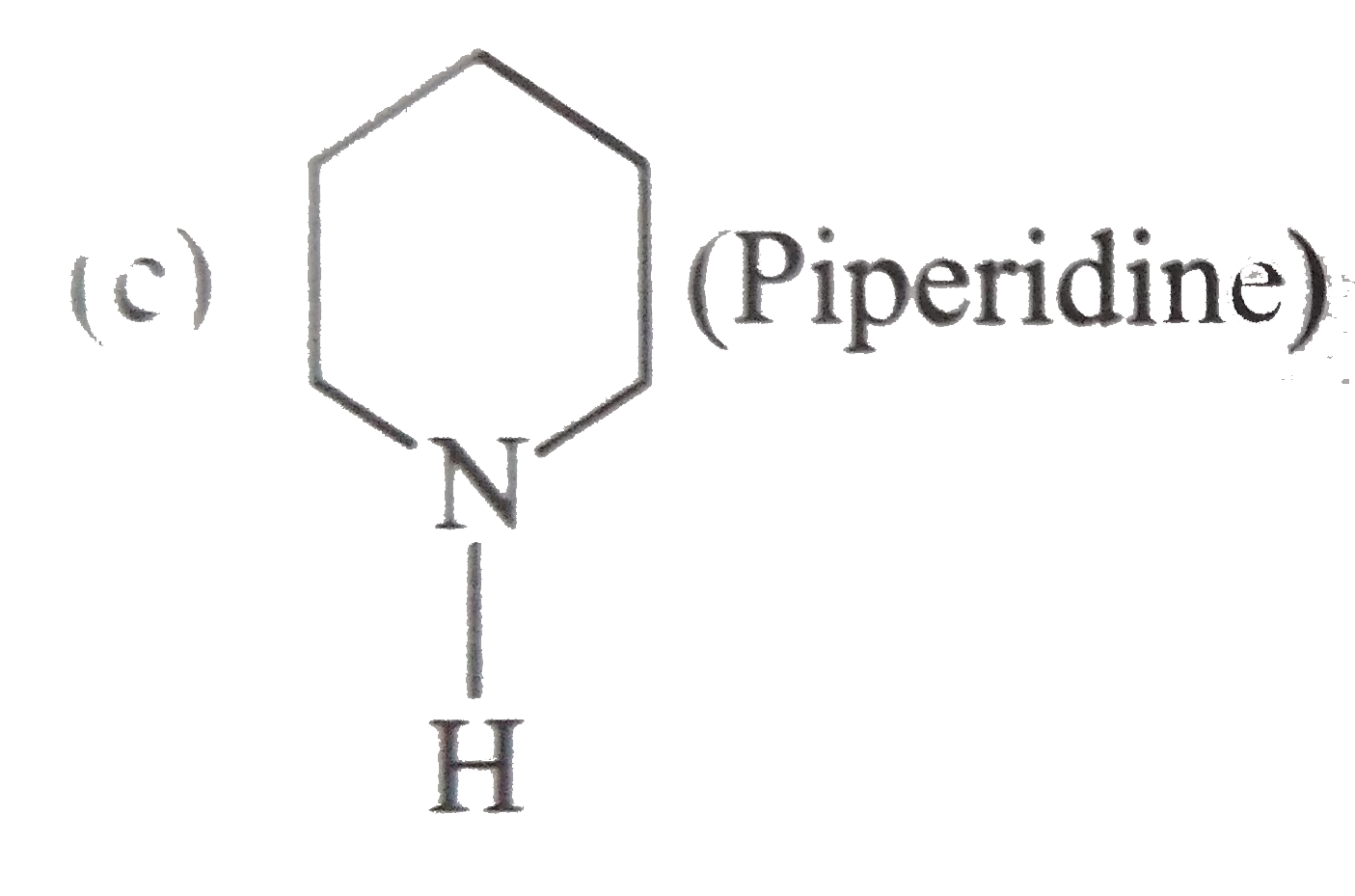One mole of an amine (A) consumes two moles of methyl bromide to give a quaternary ammonoium salt. The amine (A) is:
(CH3)3CCH2NH2
(CH3)2NCH2CH3


The correct Answer is:C
To solve the problem, we need to identify the amine (A) that can react with two moles of methyl bromide (CH3Br) to form a quaternary ammonium salt. Here is a step-by-step solution:
Step 1: Understanding the Reaction
A quaternary ammonium salt is formed when an amine reacts with alkyl halides. The general reaction for the formation of a quaternary ammonium salt from an amine can be represented as:
R3N+R′X→R3NR′+HX
where R is an alkyl group, R′ is another alkyl group, and X is a halide ion.
Step 2: Analyzing the Given Information
The question states that one mole of an amine (A) reacts with two moles of methyl bromide. This indicates that the amine must have the capacity to accept two methyl groups. This is characteristic of a secondary amine, which can be further converted into a quaternary ammonium salt.
Step 3: Identifying the Type of Amine
1. Primary Amine (RNH2): Can react with one mole of methyl bromide to form a secondary amine but cannot react with two moles to form a quaternary ammonium salt.
2. Secondary Amine (R2NH): Can react with two moles of methyl bromide to form a quaternary ammonium salt.
3. Tertiary Amine (R3N): Can react with one mole of methyl bromide to form a quaternary ammonium salt but cannot accept two moles of methyl bromide.
4. Quaternary Ammonium Salt (R4N+): Already fully substituted and cannot react further.
Step 4: Conclusion
Since the amine (A) must be able to react with two moles of methyl bromide to form a quaternary ammonium salt, it must be a secondary amine.
Step 5: Final Answer
The amine (A) is a secondary amine.
A quaternary ammonium salt is formed when an amine reacts with alkyl halides. The general reaction for the formation of a quaternary ammonium salt from an amine can be represented as:
R3N+R′X→R3NR′+HX
where R is an alkyl group, R′ is another alkyl group, and X is a halide ion.
The question states that one mole of an amine (A) reacts with two moles of methyl bromide. This indicates that the amine must have the capacity to accept two methyl groups. This is characteristic of a secondary amine, which can be further converted into a quaternary ammonium salt.
1. Primary Amine (RNH2): Can react with one mole of methyl bromide to form a secondary amine but cannot react with two moles to form a quaternary ammonium salt.
2. Secondary Amine (R2NH): Can react with two moles of methyl bromide to form a quaternary ammonium salt.
3. Tertiary Amine (R3N): Can react with one mole of methyl bromide to form a quaternary ammonium salt but cannot accept two moles of methyl bromide.
4. Quaternary Ammonium Salt (R4N+): Already fully substituted and cannot react further.
Since the amine (A) must be able to react with two moles of methyl bromide to form a quaternary ammonium salt, it must be a secondary amine.
The amine (A) is a secondary amine.
Topper's Solved these Questions
- ORGANIC COMPOUNDS CONTAINING NITROGENBOOK - OP TANDONCHAPTER - ORGANIC COMPOUNDS CONTAINING NITROGENEXERCISE - STEP II:
20 Videos
- ORGANIC COMPOUNDS CONTAINING NITROGENBOOK - OP TANDONCHAPTER - ORGANIC COMPOUNDS CONTAINING NITROGENEXERCISE - PASSAGE
16 Videos
- ORGANIC COMPOUNDS CONTAINING NITROGENBOOK - OP TANDONCHAPTER - ORGANIC COMPOUNDS CONTAINING NITROGENEXERCISE - Level A
213 Videos
- ISOMERISM (STRUCTURAL AND STEROISOMERISM)BOOK - OP TANDONCHAPTER - ISOMERISM (STRUCTURAL AND STEROISOMERISM)EXERCISE - INTEGER
7 Videos
- RADIOACTIVITY AND NUCLEAR TRANSFORMATION BOOK - OP TANDONCHAPTER - RADIOACTIVITY AND NUCLEAR TRANSFORMATION EXERCISE - SECTION - VI
3 Videos
Similar Questions
Knowledge Check
How many molecules of CH3I combines with one molecule of methyl amine to give quaternary ammonium salt ?
AOneBTwoCThreeDFourEthyl amine reacts with excess of methyl iodide to give
Aethyl methyl amineBethyl diemthyl amineCethyl trimethyl ammonium iodideDAll of theseMethyl amine is
AAmphotericBAcidic in natureCNeutral in natureDBasic in nature
The reaction of HNO2 with 'A' gives quaternary ammonium salt. A is
View SolutionMethylation of methyl amine gives
View SolutionWhich does not give methyl bromide?
View SolutionAn amine (X) on being heated with an excess of methy1 bromide produces diethyldimethy lammonium bromide The amine (X) is .
View SolutionOne mole of alkene an ozonolysis gives two moles of butanone. The alkene is :
View Solution
